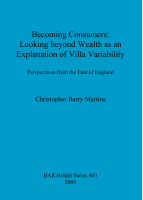Description
BOOK DESCRIPTIONThis research provides a comprehensive study of the social and psychological characteristics of modern consumer behaviour that is then used as an interpretative perspective with which to consider the evidence for a selection of villas in Roman Britain. Existing explanations for investment in the country properties of the elite are contextualised and the commonly-applied hypothesis of conspicuous consumption is critiqued.A quantifiable 'costing' model is introduced and consumer theories are summarised against a background of Roman archaeology.The consumer approach allows for a closer look at the decision-making of individuals and the determinants that can influence personal choice. Case-studies are offered that rigorously examine a range of apparently status-enhancing amenities on villas within a framework that focuses on specific consumption arguments.This process serves to question existing orthodoxies.Important and under-appreciated contexts in which social identity could be expressed were the Roman roads that passed close to villas, and this suggestion is explored.











